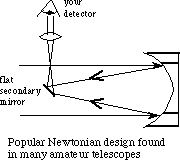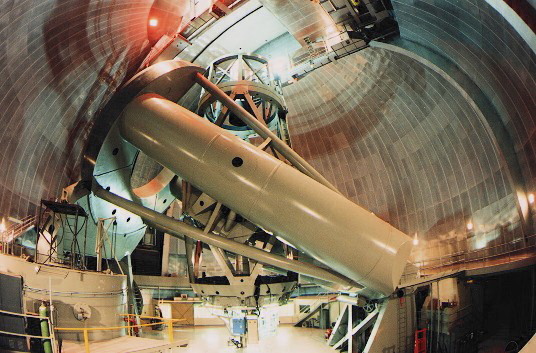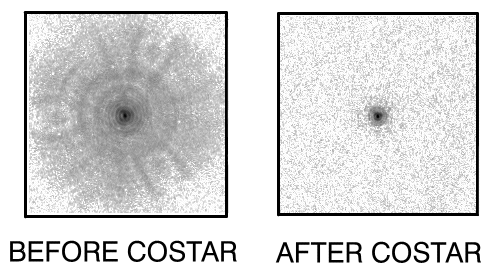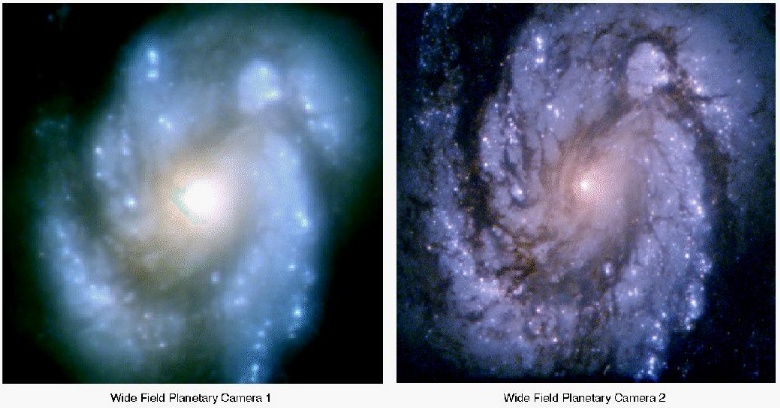

Video lecture for this chapter
The reflector telescope uses a mirror to gather and focus light. All celestial objects (including those in our solar system) are so far away that all of the light rays coming from them reach the Earth as parallel rays. Because the light rays are parallel to each other, the reflector telescope's mirror has a parabolic shape. The parabolic-shaped mirror focusses the parallel lights rays to a single point. All modern research telescopes and large amateur ones are of the reflector type because of its advantages over the refractor telescope.


Alas! Despite the advantages of the reflector telescope, astronomers must contend with some minor annoyances.
The second picture shows the path light travels in the 10-meter Keck Telescope at the W.M. Keck Observatory. The objective is composed of 36 hexagonal mirrors put together to act as one large mirror 10 meters across. Clicking on the image will give you more information about this telescope in another window. The small image next to it shows the 10-meter objective. The person in the red clothing at the center gives you a sense of scale. The Keck Observatory consists of two 10-meter telescopes placed next to each other on the top of Mauna Kea: Keck I opened in 1993 and Keck II opened in 1996. Lessons learned in building the Keck telescopes have been used to build several optical/infrared telescopes of similar or larger size since then. See the links at the bottom of the page for information about some truly huge ground-based telescopes in the works.

In both the reflector and refractor telescopes, the focus is before the eyepiece, so the image in astronomical telescopes is upside down. Telescopes used to look at things on the Earth's surface use another lens to re-invert the image right-side up. Most reflector telescopes will use a smaller secondary mirror in front of the large primary mirror to reflect the light to a more convenient viewing spot. Isaac Newton used a flat secondary mirror at a 45° angle to reflect the light to an eyepiece at the side of the telescope tube near the top. Such an arrangement, called a newtonian design is used by many amateur telescopes.
Many reflector telescope use another light path design called the cassegrain design to reflect the light back through a hole in the primary mirror, so that detectors or the eyepiece can be conveniently placed behind the telescope. Most of the large telescopes used for research, including the Hubble Space Telescope and James Webb Space Telescope, are of this design. Some of the largest telescopes like the Hale Telescope and the Keck Telescope have places to put detectors at the prime focus, where the light from the primary mirror first comes to a focus. The images in reflector telescopes do not have holes or shadows in them because the light rays from the unblocked parts of the primary mirror are all added together when they are focussed together. Even though part of the primary mirror is blocked or missing, there is still plenty of usable primary mirror space to gather the light.
Both types of telescope can suffer from a defect called spherical abberation so that not all of the light is focussed to the same point. This can happen if the mirror is not curved enough (shaped like part of a sphere instead of a paraboloid) or the glass lens is not shaped correctly. The Hubble Space Telescope objective suffers from this (it is too flat by 2 microns, about 1/50 the width of a human hair) so it uses corrective optics to compensate. The corrective optics intercept the light beams from the secondary mirror before they reach the cameras and spectrographs. Fortunately, the Hubble Space Telescope's spherical aberration is so perfect, that it is easy to correct for!

Even before the 1993 servicing mission that installed the corrective optics 2.5 years after the Hubble Space Telescope was put in orbit (launched in April 1990), astronomers were able to get significant results from the telescope. The images were computer-enhanced to correct for the spherical aberration to produce sharper images than from any ground-based telescope. Also, astronomers were able to observe ultraviolet light from celestial objects and fainter objects than could be seen from the ground. However, the computer processing took a long time and the aberration prevented the focusing of most of the light. This meant that astronomers could not see the very faint (and distant) objects they were looking for. Astronomers and the public were very pleased after the corrective optics were installed.

M 100 a few days before (left)
and after (right) the corrective optics (COSTAR) were installed in December
1993.
Ground-based telescopes larger than Keck that will outperform even the Hubble Space Telescope (in the optical and infrared bands using adaptive optics) are being built now. Here are links to some of these future very large telescopes. Selecting any of the links will bring up the site in a new window (in front of or behind this window). The diagram below compares many current and future telescopes.
![]() Go back to previous section --
Go back to previous section --
![]() Go to next section
Go to next section
last updated: January 20, 2022